IEEE-USA Harmful Interference White Paper
The document shown at right, a white paper entitled “Clarifying Harmful Interference Will Facilitate Wireless Innovation“, was released this week by IEEE-USA and was drafted by its Committee on Communications Policy. Here is the executive summary:
In recent years, many of the spectrum policy controversies in the United States have dealt with the basic issue of whether a proposed technology or service will cause “harmful interference” to existing spectrum users. Resolving these issues has typically taken several years in an era where technology is moving at “Internet speed.” As the Federal Communications Commission (FCC) discussed in its Wireless Innovation Inquiry, the delays and lack of transparency associated with making go/no go determinations on harmful interference may be discouraging private investment in the development of innovative wireless technology.
This White Paper reviews the background of what is harmful interference and suggests incremental ways in which the two spectrum management agencies in the United States, the FCC and the National Telecommunications and Information Administration (NTIA), could clarify the definition by giving guidance on the sub-problems associated with harmful interference determinations. Changing the definition is probably impractical, due to the long list of precedents over decades that have been built on the current definition, even though it is not established by statute.
The White Paper also suggests that establishing timeliness goals similar to those voluntarily created by the FCC for equally complex and voluminous merger and acquisition reviews could also address the disincentives for private capital formation in the wireless technology area. Such timeliness goals could create a more “level playing field,” with respect to other technical areas concerning private funding of technical development.
Are Cell Phone International Calling Rates Legal?
For the purpose of regulating interstate and foreign commerce in communication by wire and radio so as to make available, so far as possible, to all the people of the United States,… a rapid, efficient, Nation-wide, and world-wide wire and radio communication service with adequate facilities at reasonable charges … there is created a commission to be known as the “Federal Communications Commission” 47 USC 151
The above quote is the original reason the FCC was created in 1934 and remains in the statute today. The following provisions of 47 USC 201(b) also remain in effect
All charges, practices, classifications, and regulations for and in connection with such communication service, shall be just and reasonable, and any such charge, practice, classification, or regulation that is unjust or unreasonable is declared to be unlawful
Section 205(a) also gives the Commission authority to “determine and prescribe what will be the just and reasonable charge or the maximum or minimum, or maximum and minimum, charge or charges to be thereafter observed”.
This post is a followup to a July 2010 post titled “International Calling Rates: A Case of Market Failure?” The table below shows the rates per minute for calls from cell phones in the US from the 4 big carriers to overseas land lines. (In many other countries there is a charge for incoming calls to cell phones so there is a reasonable surcharge on calls to cell phones in such countries. Here are sources of this data: AT&T, Sprint, T-Mo, VZW. Note that this discussion concerns outgoing international calls from the US, not overseas roaming where the carriers actually do incur more costs.)
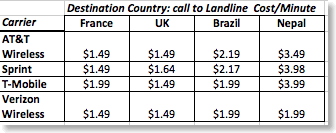
The data is for 2 European countries, a rapidly growing developing nation, and a more remote country - hopefully a reasonable cross section of types of countries. So is $1.49-3.99/minute “just and reasonable”? Readers might recall a recent post here entitled “Telecom Too Cheap to Meter” which argued that the marginal price of voice telephony is rapidly approaching zero, in great contrast to when your blogger joined FCC in 1979 when long distance and international calling rates were a big issue. But that post dealt with reference points that were not clearly applicable to the cell phone market.
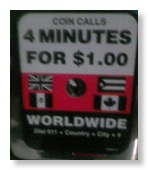
2 years ago I made a landline call to Asia to speak to my wife who was traveling there and in the haze of jet lag (having just returned myself) I hit the wrong button on our 2 line cordless phone and used Verizon rather than Vonage. The billed cost of the call was over $2/minute and totaled over $50. Being an FCC alum and knowing the cryptic corners of the FCC website, I made an informal complaint. Verizon did not fight the complaint and quietly marked the cost down to about $0.05/minute - which is a reasonable price. So I would suggest that any consumers who are billed for the above international rates of the major cell carriers to file such complaints and allege that the charge is illegal under the terms of 47 USC 201(b) and see if they capitulate the way the landline part of VZ did for me.
But FCC, why not take a pro consumer view and question the big 4 carriers on why their international rates are so out of line?
Feuding Trade Organizations
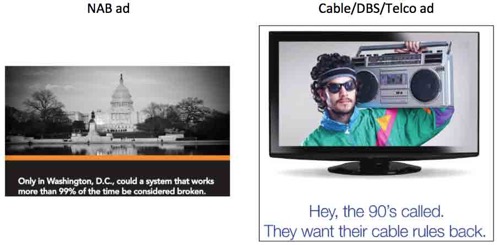
Your blogger was downtown in DC yesterday and pickup a copy of Politico, a giveaway political newspaper for those interested in Capitol Hill issues. The above two items come from ads in the 7/23 issue from the American Television Alliance (ATVA) and NAB in anticipation of a Senate hearing today on “The Cable Act at 20”.
ATVA describes itself as “ an unprecedented coalition of consumer groups, cable, satellite, telephone companies and independent programmers to raise awareness about the risk viewers face as broadcasters increasingly threaten service disruptions that would deny viewers access to the programs they and their families enjoy.” While cable companies, DBS providers and telcos are well represented, there aren’t many consumer groups in their list of members. NAB has created a corresponding website, keepmytv.org/, without creating a corresponding sham organization. keepmytv.org claims it “is dedicated to empowering viewers to have the best options for their local news, entertainment and community programming.”
I assume that most consumers know that neither NAB nor the ATVA members are really interested in them for other than being pawns in their battles.
NAB’s site says “Broadcast television is the most popular around, and we plan to stay that way.” Perhaps NAB didn’t notice the Emmy nominations for this year:
Drama Series
“Boardwalk Empire" (HBO)
"Breaking Bad" (AMC)
"Downton Abbey" (PBS)
"Game of Thrones" (HBO)
"Homeland" (Showtime)
"Mad Men" (AMC)
Comedy Series
“The Big Bang Theory" (CBS)
"Curb Your Enthusiasm" (HBO)
"Girls" (HBO)
"Modern Family" (ABC)
"30 Rock" (NBC)
"Veep" (HBO)
Thus 8 out of 12 Emmy nominations to top series this year went to nonbroadcast non networks! (We counted the PBS nomination as a broadcast network.) The networks as a group are as good as HBO in getting comedy nominations, but got skunked on drama nominations! Indeed, HBO got 5 of the 12 nominations while the commercial networks (ABC, CBS, and NBC) only got one each. Perhaps it is appropriate that 30 Rock, which ridicules network management and NBC’s acquisition by “Kabletown”, is one of the few network shows to make the list. Perhaps 30 Rock should talk about NAB also and keep up the discussion about “Kabletown”?
But the main point here is the degree to which powerful trade associations are using PR campaigns to try to frame their goals, rather than focusing on the public interest.
Battling Spectrum Reports: Mobile Future vs. PCAST
On Sunday 7/15 Mobile Future released a report entitled “Spectrum Sharing: The Promise and The Reality”, almost certainly in anticipation of the final PCAST report that was released on Friday 7/20 as had been previously announced. The PCAST report was discussed here previously when a public briefing discussed its basic findings. A year ago we introduced readers to Mobile Future in a post entitled “New Cellular Advocacy Group Trivializes Spectrum Policy Issues”. Mobile Future’s membership includes Alcatel-Lucent, AT&T, Ericsson, Qualcomm, and T-Mo but not VZW and Sprint.
Mobile Future 2011 video
The cellular industry was angry at the staffing of the PCAST report because they saw it as stacked with Silicon Valley interests. However the 21 “invited experts” (p. xvii-xviii) included Dale Hatfield, who is clearly on close terms with the cellular industry, the former R&D chief of Motorola, and Tom Wheeler, former head of CTIA. It also included 13 individuals with academic affiliations, a ratio common on Japanese government advisory committees but previously unheard of in the FCC/NTIA cases.
A July 5 article in Bloomberg BNA Telecommunications Law Resource Center™ , “Despite Calls for Spectrum Sharing, Technological, Regulatory Questions Linger” contained the basic points that the Mobile Future/Rysavy report elaborated on:
While the concept has been embraced by the FCC, NTIA, and PCAST, the chief concern of the wireless industry is that spectrum-sharing technologies might not be ready for commercial application until 2020 at the earliest.
“If you come out and start saying, 'let's share spectrum,' and there's not a means for doing spectrum sharing, you've compounded the problem,” Randall Stephenson, chairman, chief executive, and president of AT&T Inc., told reporters following remarks at a Washington event in June.
Since May, Stephenson has publicly suggested twice that spectrum-sharing technology is not ready for “prime time,” while giving his general support for the idea pending the resolution of many “what ifs.”
Note that AT&T is a member of Mobile Future and you see the connection.
The Mobile Future members want sole focus of spectrum deliberations to be on reallocation to them and view sharing as academic illusion that isn’t ready for prime time. Of course, while the industry see spectrum sharing as an unimplemented illusion, it also sees 700 MHz LTE systems for nationwide public safety voice and data with priority and preemption as a straight forward engineering task. It would be interesting if Mr. Stephenson could comment on why one is so risky and the other so straight forward.
So with all this preliminary effort the final PCAST report came out today. As Mobile Future feared, it emphasizes sharing spectrum, not reallocating it entirely to the cellular industry. This is a terrible blow to the Chinese electronics industry because it means that world wide standard equipment can not be used in all bands in the US. However, the usual Chinese made equipment will still work in many bands including all the present ones. In many cases the nonstandard features to deal with sharing spectrum will be in the base stations NOT the handsets so the CTIA membership will still be able to fill their stores with Chinese products.

Rather than focusing on the inevitable bad news about sharing, the cellular industry and other nonfederal government spectrum users show focus on and praise the first real proposals in a long time to reform federal spectrum management and create the right incentives for managing the spectrum in the national interest, not in the parochial interest of IRAC members.
I suggest that the cellular industry carefully read the following recommendations of the PCAST report and realize that for the first time (since Nixon’s OTP) they offer the hope of creating a real national spectrum management system that focuses on the national interest:
Finding 5.1: There is no incentive system today for Federal Government agencies to be efficient in their use of spectrum or to share spectrum allocated to them with the non-Federal sector.
Finding 5.2: A public private partnership (PPP) is the best mechanism to ensure that optimal use is made of the Federally-held spectrum and of related investments in spectrum research and testing.
Finding 5.3: International harmonization of spectrum policies is essential to product innovation, interoperability and roaming, spectrum efficiency, and cross-border frequency coordination.
Recommendation 5.1: PCAST recommends that the White House Chief Technology Officer (CTO) with senior officials at an equivalent level from the National Security Staff (NSS), the Office of Management and Budget (OMB), and the National Economic Council (NEC) formalize a Spectrum Management Team (SMT) to work with the National Telecommunications and Information Administration (NTIA), the Federal Communications Commission (FCC), and the
major Federal agencies that use spectrum to carry out the President’s directive.
Recommendation 5.2: PCAST recommends that the NTIA, working with the SMT and Federal agencies, reexamine the partitioning of Federal spectrum usage in light of current and emerging technology. One objective of this reexamination is to aggregate current spectrum partitions to create substantial frequency blocks in order to facilitate sharing through common technical use rules.
Recommendation 5.3: PCAST recommends that the President indicate that all Federal agencies should cooperate with the SMT and NTIA to establish and implement a government-wide process and mechanism to share Federally-held spectrum. Within one year, the SMT working with the NTIA should formulate concrete 5 year and 10year goals for Federal spectrum sharing opportunities in order to recommend to the President how to appropriately update his 2010 goal of making 500 MHz of Federal and nonFederal spectrum available over the next 10 years.
Recommendation 5.4: PC
AST recommends that OMB, working with the SMT and NTIA, take steps to implement a mechanism that will give Federal agencies incentives to share spectrum. Such a mechanism would accurately internalize the opportunity cost of Federal spectrum resources and manage them over long time horizons using a “currencylike” accounting, allocation, and incentive system (“Spectrum Currency”).
Recommendation 5.5: PCAST recommends that OMB should implement a sustainable funding mechanism to foster a Federal spectrum sharing system. The existing Spectrum Relocation Fund should be redefined as a revolving “Spectrum Efficiency Fund” that recycles private sector payments for use of Federal spectrum into reimbursements to Federal agencies for investments .
UPDATE
Trade press reports on PCAST report:
Wireless Week
FerceBroadband Wireless
GigaOm
Comm. Pai's First Public Speech Hits the Bull's Eye on Innovation
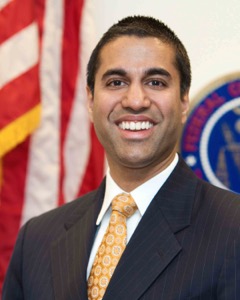
In his first major speech as a member of the Federal Communications Commission (FCC), Ajit Pai on Wednesday proposed the creation of an office for expediting the reviews of new technologies and services. In the speech at Carnegie Mellon University in Pittsburgh, Commissioner Pai, a Republican who joined the FCC in May, accused his agency of moving too slowly and stifling growth in the communications industry.
In the speech at CMU also talked at length about Section 7 of the Communications Act, a section so rarely mentioned at FCC that your blogger was seriously wondering whether it was redacted from all copies of the Act at FCC. While ignored consistently at FCC, Section 7 has been a recurring topic on this blog and there are indications that Comm. Pai’s interest might have been influenced by the discussion here.
Here is Comm. Pai’s discussion of Section 7 in case you are rusty on the details:
Now, you might be wondering: What is Section 7 of the Communications Act? You’re not alone; many communications lawyers don’t know what it is.
Let me quote the important part of Section 7, the neglected stepchild of communications law: “The Commission shall determine whether any new technology or service proposed in a petition or application is in the public interest within one year after such petition or application is filed.”
Looking at that provision, the message from Congress is clear: The Commission should make the deployment of new technologies and new services a . a priority, resolving any concerns about them within a year.
Comm. Pai proposes a new “Office of Entrepreneurial Innovation” for FCC although he suggests that this might be done by transforming the present the Office of Strategic Planning and Policy Analysis.
He states
(I)f we create an Office of Entrepreneurial Innovation, shepherding proposals for new technologies or services through the FCC will become an institutional priority and send the right signals to the marketplace. Entrepreneurs need an advocate at the FCC—one that will hold us accountable if we delay, rather than decide. And if OEI succeeds in its mission, we will see faster innovation, greater investment, and more job creation.
Finally on more general spectrum policy issues, Comm. Pai says
When it comes to spectrum policy, I believe in an “all of the above” approach. Does the FCC need to make available more spectrum bands for wireless broadband? Yes. Do we need to reform the federal government’s management of its spectrum so that more can be made available for private-sector use? Yes. Does the FCC need to expedite its review of secondary market transactions? Yes. Is there a place for geographic spectrum sharing? Yes. Is there a place for unlicensed use? Yes. Do we need to do more to promote the efficient use of spectrum? The answer, again, is yes.
A virtuoso performance! However, many incumbents with good access to 8th Floor decision making probably don’t agree that innovation, other than their own innovation, is a great idea. During its heyday as the dominant mobile radio manufacturer, the old Motorola maintained its market hegemony in Part 90 (private land mobile) market by manipulating FCC rules to keep out innovation that would disrupt their market share out of the marketplace. Indeed, this is the very reason Section 7 was passed in 1983 after Motorola and its allies in the Part 90 user community derailed a new land mobile radio technology (ACSB) from a new entrant!
The speech ended with these impressive words,
Finally, the agenda that I have described today is a work in progress. This speech should be the beginning of a conversation, not the end of one. If you have thoughts on how the FCC can help accelerate economic growth and job creation, tell me. If you have a new idea for how the FCC can become more nimble, promote investment, or allocate additional spectrum for mobile broadband, let me know. Please do not hesitate to contact my office. We have an open-door policy, and we encourage you to take advantage of it. You can even reach out to me on Twitter; my handle is @ajitpaifcc. It doesn’t matter whether you represent a Fortune 500 company, a start-up with three employees, a public interest group, or just yourself. A good idea is a good idea, and I want to hear as many of them as possible.
Although our nation has been going through tough times these last few years, I am confident that our economy will rebound strongly, and that the ICT sector can help lead the way. We see a glimpse of that future here in Pittsburgh. And if we pursue the right policies in Washington, DC, we can remove barriers to investment and innovation and unleash a wave of economic growth and job creation all across the country. Working together, I know we can make it happen. Thank you very much.
FCC Hiring: Why is recruiting of lawyers so different than for engineers?
The recruiting of lawyers at the beginning of the Fall term is a long standing tradition at FCC that has been discussed here before. The only way to get the best people is to go when recruiting of the graduating class starts. Yet for engineers, recruiting must always wait until the budget is finalized which in the current political environment is in the Spring. Indeed, this year FCC did not even officially announce jobs for entry level engineers until May! While it is necessary for FCC managers to say they have hired great engineers, it is clear that the pickings are pretty slim if you wait until late in the school year to even look.
On the webpage for the FCC lawyer recruiting program it states
“Specific placements within the agency will be based on the participant’s interests and experience and the needs of the FCC. Participants may have the opportunity to rotate to a new assignment within the agency at the end of their first year. During their two years in the Honors Program, attorneys also will be afforded professional and educational opportunities designed specifically for Program participants.”
While I worked at FCC I repeatedly pushed for an analogous rotation program for entry level engineers. It was specifically rejected because the bureau chiefs who employ engineers are interested in their near term problems which are generally processing delays for various types of licenses and view entry level engineers as “cannon fodder” to fight such processing battles. The concept of development of staff engineers for future work in policy areas is not on their mind.
Note that the Nuclear Regulatory Commission explicitly offers rotations for entry level hires in both engineering and legal fields. The National Security Agency, reportedly the government largest employer of electrical engineers, offers new employees various types of career development to both attract good applicants and enhance their careers.
When I joined FCC, the headquarters engineering staff included some individuals who had started in the old FOB (now EB) in enforcement field offices who had solved real problems “outside the beltway” and knew the operational aspects of the telecom industry. In myopic budgeting decisions this has become very rare because FCC now jumps through hoops to avoid paying any relocation costs for personnel and has essentially told field personnel not to expect a job in DC unless they agree to not ask for any relocation costs. James McKinney, Carlos Roberts, and Dick Smith are all FOB field alumni who moved to DC and became bureau/office chiefs. This lack of mobility both hurts recruiting and hurts engineering staff development.
When I was on active duty in the Air Force at the end of the Viet Nam War, I was puzzled why the Air Force was forcing people out to downsize at the same time it was recruiting new entry level enlisted men and officers. I asked a wise old colonel I worked with and he explained it very simply and clearly: The US Air Force will be around 10 years, 20 years and more from now at some size that is hard to predict. It will always need a mixture of people with differing years of experience and differing ranks. If you turn off the entry spigot or get the wrong people, than years into the future there will be major staffing problems.
That is problem with FCC. Staffing people look at near term goals not long term institutional needs. I do not know how big FCC will be in 2020. I do not know how many engineers it will need in 2020. But I do know that FCC, or any organization that might replace it, will need a mixture of high quality engineers with a mix of experiences.
Docket 10-4: 6+ Years of FCC Inaction Turns an Emerging Interference Issue into a "Lose/Lose" Situation
On November 2, 2007, CTIA, the Wireless Association (CTIA) filed a Petition for Declaratory Ruling (CTIA Petition) regarding the proper use of signal boosters in Commercial Mobile Radio Services (CMRS).
Hence there was no explanation for the over 2 year delay in responding to this petition from a very powerful trade association. If a trade group as powerful as CTIA can be ignored for 2+ years, one wonders how much attention a mere startup company would get? Since the 1st Amendment guarantees the right “to petition the Government for a redress of grievances” and the APA reiterates this right, "Each agency shall give an interested person the right to petition for the issuance, amendment, or repeal of a rule" (5 USC 553(e)), it is puzzling that FCC in recent decades have given most petitions such little attention. When Bob Foosaner was head of WTB’s predecessor in the 1980s, he argued pragmatically that petitions had to be either dismissed or put out for public comment in about a month, for otherwise the embarrassment of inaction impacts the real options.
(While the delay from the filing of the petition to the FCC PN was 26 months, the petition included as an attachment a “WHITE PAPER ON THE HARMFUL IMPACTS OF UNAUTHORIZED WIRELESS REPEATERS” that had been submitted to FCC on May 1, 2006! Thus CTIA had formally contacted FCC about the interference from bidirectional amplifiers almost 4 years before FCC took any public action, such as asking for comments, on this issue! Below is a section heading from the CTIA 2006 white paper)
![]()
Unfortunately CTIA’s documents failed to recognize that although early amplifiers sometimes caused interference, they were also of real benefit to consumers who suffered from marginal cellular coverage especially in rural areas. They also were very popular among public safety users, although they also complained about interference from early models (still permitted due to the impasse in this proceeding). Thus the total prohibition of amplifiers that CTIA sought was unreasonable, although it took a long time for key CTIA members to come to this realization.
We have argued here previously that emerging interference issues are inevitable in the dynamic wireless area and need to be addressed and “nipped in the bud” before they get worse. The 10+ year delay of dealing with police radar detector interference to VSAT terminals is an example of ignoring a problem until it becomes unmanageable and then putting burdens on all involved to solve it. (FCC has never even acknowledged publicly that it was aware of this problem for 10+ years before taking action!)
So what has happened in the 6+ years since CTIA’s white paper was filed? Since there has been no regulation adopted to address the issue of amplifiers that oscillate like PA systems with a microphone too close to the speaker, low end manufacturers still sell such amplifiers in the US market and presumably continue to cause interference. High end US-based manufacturers have switched to designs that are protected from oscillations and do not cause this interference - although the present designs they might cause much less frequent problems through more obscure mechanisms. However, due to regulatory inaction by FCC, low end manufacturers can continue to sell early generation units that can and do oscillate and cause interference to cellular systems.
So,
- Cellular operators continue to get interference from existing and new amplifiers that come from low end manufacturers and which continue to be legal in the current regulatory impasse.
- Legitimate amplifier manufacturers with updated designs that don’t oscillate suffer price competition from low end makers who undersell them with equipment that threatens cellular systems AND during the pendency of this rulemaking have limited access to new capital for improved equipment design due to regulatory uncertainty during the tendency of this proceeding. At least one of these manufacturers actually makes the units in a small US town in a “red state”. One new US entrant who contacted me several years ago about entering the market with an oscillation-protected design never got the financing he needed - probably due to regulatory uncertainty.
A true “lose/lose” situation! Due to the deadlock both sides (as well as the public) suffer!
Meanwhile the CTIA membership can’t make up its mind what the powerhouse should press for and meanders like a rudderless ship. A recent filing has a table summarizing the positions of the various carriers with respect to the “Joint Proposal” of Verizon Wireless and Wilson Electronics for reasonable regulation of amplifiers.
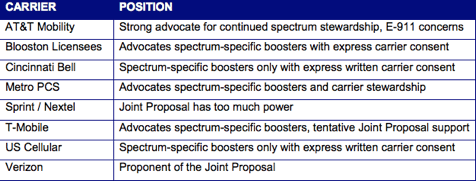
Comparison of carrier positions from Millard/Raines Partnership 5/12 filing
What is needed here is some real leadership either in the cellular industry or at FCC. While reasonable people can disagree on the best solution, most will agree that a solution is in everyone’s interest. Perhaps FCC should send an ultimatum to the industry to come up with a unified position within 2 months or else FCC will moved directly to a decision based on the current record.
It is nice to try to be everyone’s friend, but that is not a good way to run a regulatory agency in a fast moving technical area. Some times you just have to make a decision and move on.
It has been over 6 years since CTIA said
![]()
Now is the time for action! This problem is not “rocket science”, rather the impasse reflects a basic problem in FCC spectrum policy: an unwillingness to tackle basic Title III issues that are part of the Commission’s basic charter.
If the FCC IG had a good understanding of his role, he would investigate how this mess developed at FCC so the Commission can learn from these events. Don’t hold your breath, though.
So let me make a modest suggestion to resolve this impasse:
In effect the Commission is now using an informal nontransparent version of negotiated rulemaking (neg/reg) to resolve this problem. It is waiting for the parities to reach consensus - they aren’t.
As I indicated previously, while neg/reg has been successful in Executive Branch agencies, it has never been successful at FCC. I believe the reason is that neg/reg depends on a fear by all affected parties involved that the agencies will quickly make its own decision if negotiations fail to reach a consensus. In a multimember commission like FCC the parties generally feel they can just take an impasse to the 8th Floor and start all over again. Thus I propose that the Commission quickly convert this proceeding to a formal negotiated rulemaking one with a short time frame, say 60 days AND delegate, pursuant to Section 5(c) of the Communications Act, the authority to issue an NPRM and a Report & Order to one commissioner who is solely responsible for the negotiated rulemaking. Thus the neg/reg committee members will see that escalating the issue to 8th Floor politics is pointless and it is time to make real concessions while the issue is under their control. Hopefully just deciding to act this way may pressure the parties involved to reach a timely consensus without the formality of neg/reg and lead directly to timely resolution of these issues.
This type of issue should not take more than 6 years to resolve! The delay highlights a major problem in Title III policy development at FCC: an unwillingness to make timely decisions on the bread and butter issues that are necessary for efficient spectrum policy. If the commissioners would like to spend their time on grander issues, they should develop alternatives to deal with these issues. Section 5(c) gives they great flexibility in improving FCC throughput. Resolving all issues with 5 presidential appointees is not really practical in today’s complex environment.
When FCC first met in 1935, it created 3 parallel committees of (the then 7) commissioners (called “divisions” at the time) so the 3 committees could work in parallel. Today’s industry and technology is much more complex than in 1935 and the 1946 APA makes decision making much more complex. The delay in this proceeding shows that the present structure just isn’t working and all parties are suffering as a result.
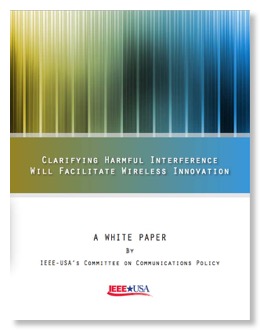

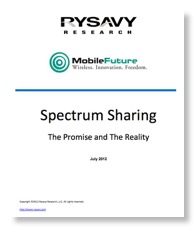
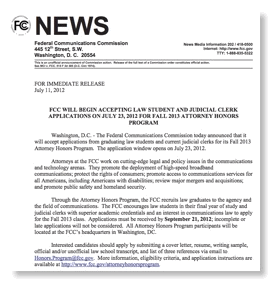

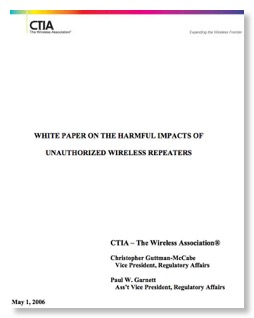



![Validate my RSS feed [Valid RSS]](valid-rss-rogers.png)

